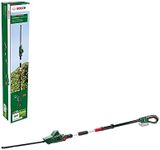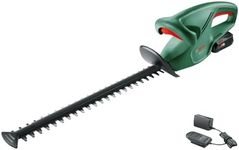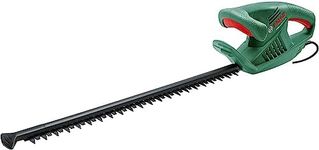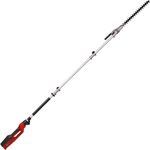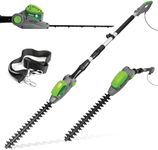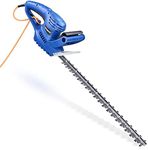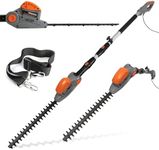Buying Guide for the Best Electric Hedge Trimmers
Choosing the right electric hedge trimmer can make your gardening tasks much easier and more efficient. When selecting a hedge trimmer, it's important to consider various specifications to ensure you get a model that suits your needs. Here are some key specs to look at and how to navigate them.Blade LengthBlade length refers to the length of the cutting blade on the hedge trimmer. This spec is important because it determines how much hedge you can trim in one pass. Blade lengths typically range from 16 inches to 24 inches. If you have small hedges or detailed trimming work, a shorter blade (16-18 inches) will be easier to maneuver. For larger hedges or more extensive trimming, a longer blade (20-24 inches) will cover more area quickly.
Power SourceElectric hedge trimmers can be corded or cordless. Corded models are powered by plugging into an electrical outlet, providing continuous power without the need for recharging. They are ideal for long trimming sessions but require access to a power source and may limit mobility due to the cord. Cordless models run on rechargeable batteries, offering greater mobility and ease of use without worrying about cords. However, they need to be recharged periodically and may have limited runtime. Choose corded if you have easy access to power outlets and need uninterrupted power, or cordless if you prefer freedom of movement and have smaller trimming tasks.
WeightThe weight of the hedge trimmer affects how easy it is to handle and use for extended periods. Lighter models (under 6 pounds) are easier to maneuver and less tiring, making them suitable for smaller tasks or users who may not have a lot of strength. Heavier models (over 6 pounds) may offer more power and durability but can be more challenging to use for long periods. Consider your physical strength and the duration of your trimming tasks when choosing the weight.
Cutting CapacityCutting capacity refers to the maximum branch thickness the hedge trimmer can cut through. This is usually measured in inches and ranges from 3/8 inch to 1 inch. If you have thin branches and light trimming work, a smaller cutting capacity (3/8-1/2 inch) will suffice. For thicker branches and more demanding tasks, look for a higher cutting capacity (3/4-1 inch). Assess the type of hedges and branches you need to trim to determine the appropriate cutting capacity.
Safety FeaturesSafety features are crucial to prevent accidents and ensure safe operation. Common safety features include blade guards, dual switches, and automatic shut-off. Blade guards protect you from accidental contact with the blades, while dual switches require both hands to operate the trimmer, reducing the risk of accidental activation. Automatic shut-off stops the trimmer if it gets jammed or overheated. Prioritize models with robust safety features, especially if you are new to using hedge trimmers or have safety concerns.
ErgonomicsErgonomics refers to how comfortable and easy the hedge trimmer is to use. Look for features like adjustable handles, cushioned grips, and balanced weight distribution. These elements can reduce strain and fatigue, making the trimmer more comfortable to use for extended periods. If you plan to do a lot of trimming or have physical limitations, prioritize models with good ergonomic design to enhance your comfort and efficiency.
